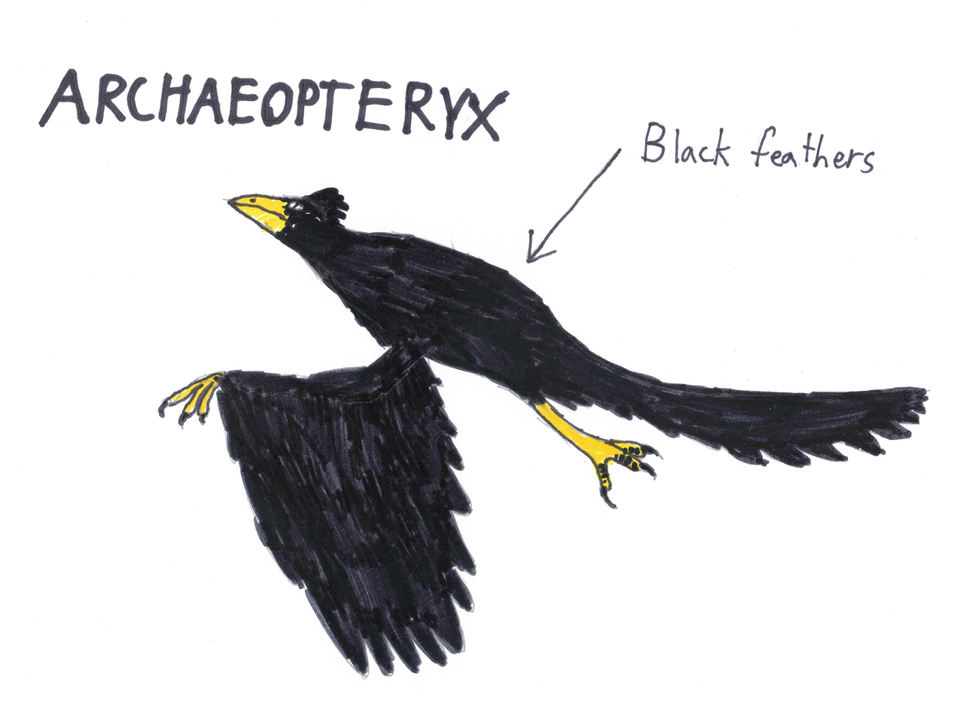Colouration of Dinosaurs

Dinosaur fossils can tell us a lot about them. But it is challenging to reveal the colours of these reptiles. The first dinosaur to be put in colour was the Anchiornis. The way to find dinosaur colours is to look at the two types of melanosomes: eumelanin and pheomelanin. It has helped palaeontologists to discover more proof of what colour dinosaurs were. Some may have been bright or dull or striped or spotted. But as for the species of dinosaurs, scientists still do not know too much about the colours; they have to make educated guesses.
Dinosaurs are prehistoric reptiles. Dinosaurs came in all shapes and sizes. They ranged in size from the 1 ft tall Compsognathus (pretty jaw) to the 90 ft tall Brachiosaurus (arm lizard). Some are very well known, such as Tyrannosaurus rex (tyrant lizard king). Others are not that famous, including Pegomastax (strong jaw). Nevertheless, these magnificent creatures still perplex scientists.
The colouration of most dinosaurs is still unknown to scientists. Although some fossil records hold pigments and melanosomes, it is still hard to tell a dinosaur's natural colour. It is because there was absolutely no way to know a dinosaur's appearance throughout the history of palaeontology. For a fossil to indicate the colour of these creatures, it must have organic matter.
In 2012 Scientists found that the bird-like dinosaur Archaeopteryx (early bird) was probably black. Black was standard among feathered dinosaurs such as Microraptor (small thief). The first dinosaur to be fully restored in colour was Anchiornis (near bird), a small theropod discovered in 2009. Then more dinosaurs started getting coloured in.
Hand drawn illustration of Archaeopteryx, created by Aahil Aidh Ibrahim Waheed
In animals, the cells containing a substance called melanin which has the light-absorbing pigment is referred to as Melanosomes. Melanosomes vary their shape and size for different animals. As a result, melanin can survive in fossils for centuries. There are different types of melanosomes. They are eumelanin which gives shades of black and brown, and phaeomelanin which gives shades of orange and red. By observing the shape of these organelles found in scales, feathers, and skin, palaeontologists colour many dinosaurs and animals that have gone extinct now.
Paleontologists Michael Benton and Zhonghe Zhou with their team discovered that Sinosauropteryx (Chinese reptilian wing), a small theropod, probably had reddish-orange and white rings on its tail.
Hand drawn illustration of Sinosauropteryx, created by Aahil Aidh Ibrahim Waheed
Because of pheomelanin, some areas of its tail were rusted orange. The feathery filaments of Sinornithosaurus (Chinese bird lizard), another small theropod, suggest that its unique colour of feathers varied between black and rusted orange. So although the colours of many other dinosaurs are still a mystery, scientists do have ideas on what colours dinosaurs may have been.
The frills of dinosaurs such as Triceratops (three-horned face), Styracosaurus (spiked lizard), Protoceratops (first horned face), Kosmoceratops (ornamented horned face), Xenoceratops (horned face), Einiosaurus (buffalo lizard) and Pachyrinosaurus (thick nosed reptile) may have brightly coloured skin. Some dinosaurs had bright colours to scare predators that would threaten them or scare off rivals. Colours also may have helped to attract a mate. The fact that birds, relatives of dinosaurs, can see colour supports this theory.
Stegosaurs, such as Stegosaurus (roof lizard), Tuojiangosaurus (Tuo river lizard), and Kentrosaurus's (sharp point lizard) backplates may have filled with blood creating a bright display to confuse would-be predators. Ceratopsians such as Psittacosaurus (parrot lizard) and Ankylosaurs such as Boreapelta (northern shield) may also have been reddish. Some dinosaurs also may have been dull in colour in shades of green and brown. It may have helped them to camouflage in rocks, trees and mud. It may have allowed the prey to hide from danger or helped predators ambush prey. The Ankylosaurus's (fused lizard) body armour may have filled with blood when disturbed, turning it pink. Some scientists think some dinosaurs may have been in red, purple, blue, green, and yellow with spots and stripes like today's lizards and snakes.
The various colours of dinosaurs tell different stories. By reconstructing the unique shades of dinosaurs, palaeontologists can find out more about their behaviour. We have just been drawing most dinosaurs in whatever shade we think is suitable throughout the years. Even though the scientist's findings have many dinosaurs in colour now, all of them are pretty small. For example, the Boreapelta measures less than two times dinosaurs' length, such as the Giganotosaurus (giant southern lizard). Scientists have still not found the colours of more enormous dinosaurs such as the Sauropod Brachiosaurus. Even today, palaeontologists are still discovering new things about these fantastic ancient reptiles.
REFERENCES
100 Things to Know About Science by Alex Frith, Minna Lacey, Jerome Martin & Jonathan Melmoth (2015)
Deadly Dangerous Dinosaurs by Rupert Matthews (2019)
The Ultimate Guide Dinosaur by Miles Kelly (2016)
https://www.scholastic.com/teachers/articles/teaching-content/what-color-were-dinosaurs/
https://www.smithsonianmag.com/science-nature/colors-dinosaurs-open-new-window-study-past-180972070/
https://www.sciencefocus.com/nature/dinosaurs-now-in-colour/
https://www.calacademy.org/explore-science/a-colorful-past
Author biography
Aahil Aidh Ibrahim Waheed commonly known as Aidh is 9 years old. He liked dinosaurs from a very young age and wants to become a palaeontologist when he grows up. He likes to read books, especially about dinosaurs and animals. His favourite author is Miles Kelly. He also makes robots and likes to build structures from Lego. He is very active and likes sports, especially football.
Cite this article as:
Aahil Aidh Ibrahim Waheed, Colouration of Dinosaurs, theCircle Composition, Volume 2, (2022). https://thecirclecomposition.org/colouration-of-dinosaurs
